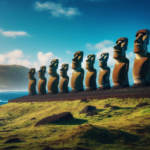Introduction
In the serene and picturesque landscape of the Scottish Highlands, nestled within the deep waters of Loch Ness, lies one of the world’s most enduring mysteries—the Loch Ness Monster. Known affectionately as “Nessie,” this legendary creature has captivated the imaginations of people worldwide for centuries. From ancient folklore to modern-day sightings and scientific investigations, the Loch Ness Monster remains a subject of fascination, debate, and speculation.
Historical Background
Ancient Legends and Folklore
The legend of the Loch Ness Monster dates back to ancient times, with references to mysterious aquatic creatures in Scottish folklore. The earliest recorded mention of a creature in Loch Ness can be found in the “Life of St. Columba,” written by Adomnán in the 7th century. According to the text, St. Columba encountered a “water beast” in the River Ness, which flows from Loch Ness, and commanded it to retreat, saving a swimmer from its clutches. This tale laid the groundwork for the enduring myth of a monstrous inhabitant in Loch Ness.
The Modern Legend Begins
The modern era of the Loch Ness Monster legend began in the 1930s, when a series of high-profile sightings brought international attention to the phenomenon. In 1933, George Spicer and his wife reported seeing a large, unidentified creature crossing the road near the loch. Their account, along with subsequent sightings, sparked a media frenzy and led to the creature being dubbed the “Loch Ness Monster.”
The Sightings
Early Sightings and Eyewitness Accounts
Over the years, numerous individuals have claimed to have seen the Loch Ness Monster. Some of the most notable early sightings include:
- 1933: The Spicer Sighting: George Spicer and his wife reported seeing a “most extraordinary form of animal” crossing the road in front of their car. They described it as large, with a long neck and a bulky body.
- 1934: The Surgeon’s Photograph: Perhaps the most famous image associated with the Loch Ness Monster, this black-and-white photograph was taken by Dr. Robert Kenneth Wilson. It appeared to show a serpent-like head and neck emerging from the water. The photograph was later revealed to be a hoax, but it remains an iconic image in Nessie lore.
Notable 20th Century Sightings
The 20th century saw numerous sightings of the Loch Ness Monster, with some gaining significant media attention:
- 1954: The Dinsdale Film: Tim Dinsdale, an aeronautical engineer, captured what he believed to be footage of the Loch Ness Monster. His film, showing a hump moving across the loch, was analyzed by experts, some of whom deemed it credible evidence of an unknown creature.
- 1977: The Campbell Sighting: Shirley Campbell reported seeing a large, dark shape moving through the water while on a boat tour. Her sighting was corroborated by other passengers, adding to the credibility of the account.
Contemporary Sightings
In the 21st century, sightings of the Loch Ness Monster continue to be reported, albeit with the added element of modern technology. High-resolution cameras, drones, and sonar equipment have all been employed in the search for Nessie:
- 2011: The George Edwards Photograph: Edwards, a local boat tour operator, claimed to have captured a photograph of a large, dark shape in the water. His image sparked renewed interest and debate over the existence of the Loch Ness Monster.
- 2020: The Webcam Sighting: During the COVID-19 pandemic, a webcam set up to monitor Loch Ness captured footage of a large, unidentified object moving through the water. The sighting was widely discussed online, with some suggesting it could be evidence of Nessie.
Theories and Explanations
Cryptozoology: The Study of Unknown Creatures
Cryptozoology, the study of hidden or unknown animals, has long been fascinated by the Loch Ness Monster. Proponents of cryptozoology suggest that Nessie could be a surviving member of a prehistoric species, such as a plesiosaur or a long-necked seal. These theories, while speculative, provide a framework for understanding the creature within the context of known animal biology.
Misidentifications and Hoaxes
Skeptics argue that many reported sightings of the Loch Ness Monster can be attributed to misidentifications of common animals, floating debris, or natural phenomena. Birds, otters, and seals have all been suggested as potential explanations for Nessie sightings. Additionally, several high-profile hoaxes, such as the Surgeon’s Photograph, have cast doubt on the authenticity of some evidence.
Geological and Environmental Factors
The unique geological and environmental characteristics of Loch Ness may also play a role in the mystery. The loch is one of the largest and deepest bodies of freshwater in the British Isles, with depths reaching over 700 feet. The dark, peat-stained waters and complex underwater topography can create optical illusions and make it difficult to identify objects below the surface.
The Role of Technology
Advances in technology have both helped and hindered the search for the Loch Ness Monster. Sonar scans, underwater photography, and DNA analysis have all been employed to investigate the loch. While these tools have yet to provide definitive proof of Nessie’s existence, they have contributed valuable data and insights into the loch’s ecosystem.
Scientific Investigations
The Loch Ness Investigation Bureau (LNIB)
Founded in 1962, the Loch Ness Investigation Bureau was one of the first organized efforts to scientifically study the loch and search for evidence of the monster. The LNIB conducted numerous expeditions, utilizing cameras, sonar, and other equipment to monitor the loch. While they did not uncover conclusive evidence of Nessie, their efforts laid the groundwork for future research.
The 1970s Sonar Studies
In the 1970s, a series of sonar studies were conducted to explore the depths of Loch Ness. These studies, led by researchers such as Robert Rines and the Academy of Applied Science, produced intriguing results, including sonar images of large, moving objects. Some of these images were interpreted as potential evidence of a large, unknown creature inhabiting the loch.
Modern Research Efforts
Recent scientific investigations have employed cutting-edge technology to search for the Loch Ness Monster:
- Environmental DNA (eDNA) Analysis: In 2018, a team of researchers led by Professor Neil Gemmell conducted an eDNA survey of Loch Ness. By analyzing water samples for traces of DNA, they aimed to catalog the species present in the loch. While they did not find evidence of a large, unknown creature, they did identify a significant population of eels, leading to speculation that Nessie could be a giant eel.
- Sonar and Underwater Drones: Modern sonar equipment and underwater drones have been used to scan the loch’s depths and explore areas previously inaccessible. These efforts have provided detailed maps of the loch’s topography and identified objects that warrant further investigation.
Cultural Impact and Media Representation
Nessie in Popular Culture
The Loch Ness Monster has become a cultural icon, appearing in countless books, movies, TV shows, and other media. Some notable examples include:
- Movies: Films such as “The Loch Ness Horror” (1982) and “Loch Ness” (1996) have brought the legend to the big screen, often blending fiction with elements of the real-life mystery.
- TV Shows: The legend of Nessie has been featured in numerous documentaries and TV series, including “In Search of…” and “MonsterQuest,” which have explored the evidence and theories surrounding the creature.
- Literature: The Loch Ness Monster has inspired a wide range of literary works, from children’s books to scientific treatises. Notable examples include “The Loch” by Steve Alten and “The Loch Ness Monster: The Evidence” by Steuart Campbell.
Tourism and Local Economy
The legend of the Loch Ness Monster has had a significant impact on the local economy, drawing tourists from around the world to the shores of Loch Ness. Visitors flock to the area in hopes of catching a glimpse of Nessie or exploring the loch’s natural beauty. Boat tours, visitor centers, and souvenir shops all capitalize on the enduring fascination with the monster, making it a vital part of the region’s tourism industry.
The Annual Loch Ness Marathon
In addition to its cultural and economic impact, the Loch Ness Monster has inspired events such as the Loch Ness Marathon. Held annually, this marathon attracts runners from around the globe, offering a scenic route along the shores of the loch and the opportunity to immerse oneself in the legend of Nessie.
The Skeptical Perspective
Critical Analysis of Evidence
Skeptics argue that much of the evidence for the Loch Ness Monster can be explained by natural phenomena, hoaxes, and misidentifications. They point to the lack of conclusive scientific proof and the many instances where purported evidence has been debunked. For example, the infamous Surgeon’s Photograph, once hailed as definitive proof of Nessie’s existence, was revealed to be a staged hoax involving a toy submarine and a plastic head.
Psychological and Sociological Factors
Some researchers suggest that psychological and sociological factors play a significant role in the Loch Ness Monster phenomenon. The power of suggestion, combined with the human tendency to seek patterns and make sense of ambiguous stimuli, can lead to genuine belief in sightings. Additionally, the cultural and economic benefits of the Nessie legend provide incentives for perpetuating the myth.
The Allure of the Unknown
Despite the lack of conclusive evidence, the legend of Loch Ness endures. Perhaps it’s the sheer size and depth of the loch, a vast freshwater expanse that feels primeval and unexplored. Maybe it’s the human fascination with the unexplained, the thrill of the unknown lurking just beneath the surface. The possibility that a prehistoric relic or undiscovered species could exist in such a remote location sparks our imagination.
Nessie: More Than a Monster
Loch Ness has become more than just a habitat for a legendary beast. It’s a thriving ecosystem teeming with life, a microcosm of the natural world waiting to be unraveled. The ongoing quest for Nessie has led to a surge in scientific research, furthering our understanding of freshwater lochs and their inhabitants.
The Legacy of Nessie
Whether Nessie is a collective hallucination, a giant eel, or something entirely different, its legacy is undeniable. It has become a symbol of Scotland, a global tourist draw, and a testament to the enduring power of myth and legend. The legend of Loch Ness reminds us that even in our modern world, there’s still room for mystery, a space where wonder and scientific inquiry can coexist. As long as the loch’s depths remain shrouded in mist, the legend of Nessie will continue to capture hearts and inspire exploration.
The Future of Loch Ness
The search for Nessie may continue, but the true focus is likely to shift. Technological advancements in underwater exploration and environmental monitoring offer exciting possibilities. Perhaps one day, advanced DNA analysis or a high-definition glimpse will definitively answer the question: is Nessie real? But even if the answer is a resounding no, the legend will undoubtedly live on. For Loch Ness, with its haunting beauty and captivating mystery, will forever hold a special place in our collective imagination.












